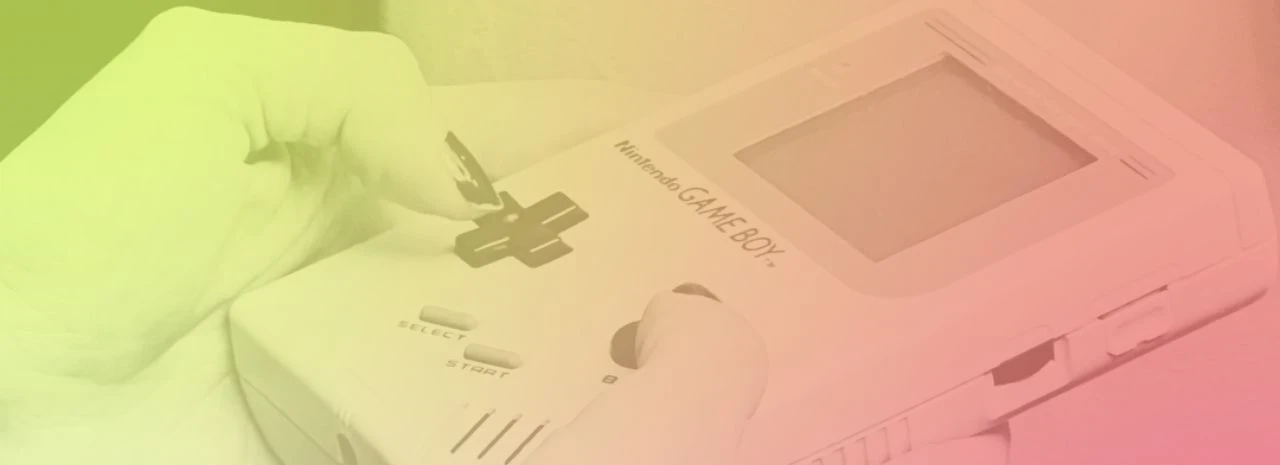When I joined Monogram last year I was surprised to find the team at a web-focused design agency making something on Game Boys. I didn’t expect it given that the Nintendo Game Boy was launched in 1989; the same year as the web was invented. But it looked like a whole lot of fun! A few months on I took the opportunity to sit down with Monogram’s Founding Director, Colin Hayward, and Developer, Dan Humphries, to find out what they were up to, what they hoped to achieve and their reflections now that it’s finished.
Q When I joined Monogram, I found the team building a custom game for a retro console. Why was that?
Colin: We had the opportunity to present our capabilities to the wider team at one of our long-standing agency partners. We wanted to do something a little different to demonstrate our creative use of technology. We hadn’t done anything quite like this before and didn’t know if it was within our capabilities, so we decided to challenge ourselves. Being able to walk our talk is important to us. Presenting to an entertainment client gave us a great opportunity and the perfect environment to do just that.
Throwing it back to 1989
Q Where did the idea of using Game Boys come from?
Colin: I find a lot of creative ideation comes from a variety of different, and sometimes random, channels. I often hold things in the back of my head and do something else. Sometimes ideas will just come and other times the dots join together further down the line. This particular idea was a combination of things which were then triggered by a blog I read mentioning a game creation tool for Game Boy. That was my ‘oh my goodness, can you imagine’ moment!
Q What was the reaction from the team when you suggested this?
Dan: When Colin came to me with the idea of us creating a custom-built Game Boy game to use in a presentation, my initial reaction was a combination of ‘What a cool idea’ and ‘Are you nuts?!’ I wasn’t sure if we could do it or how it would work.
Colin: Typically in our work, we iterate to improve things; we’ll use a new piece of tech in development or try something new within a project to improve on a process. That’s how we improve and progress, but since our work is usually commercial we don’t take risks – not with client work. This however was different. In this case, I told Dan I wanted to jump from here to here. There was no iteration, we just leapt across the chasm! That was a big ask and a big push – and that’s why Dan thought I was nuts!
Q Did you think there would be value in this project?
Dan: My initial opinion was that I wasn’t sure it was worth us spending time learning this tool. I just couldn’t see that it was something we’d ever do again. What soon became clear was that it didn’t matter. If we spent time learning to use this tool and producing this game it would be meaningful regardless of whether or not we’d ever use it again. Going through this process was enough to demonstrate to ourselves and others just how flexible we are and that we are capable of crazy stuff like this! It was an out there idea, but it paid off!
Colin: We love a challenge! By making ourselves the client, we were able to ask and answer the question of ourselves ‘Is this something we can do?’ It was a great opportunity to challenge ourselves. We put ourselves right on the very edge of our comfort zone, but not completely out of it. The result was that we could not only do it but create something pretty cool. I have no doubt there’s value in that alone.
Taking risks
Q Did it feel like you were taking a risk working on this project?
Colin: Everything we did was a calculated risk. Yes, we spent development time on this, but we didn’t use years' worth of development time on it – that would’ve been too great a risk. We didn’t spend thousands of pounds on kit, that also would have been a risk too far. We checked in regularly with ourselves to make sure that if this didn’t work out, that would still be ok and we’d still get something out of doing this work. At the very least, we would still learn and grow as a team, and my kids would have a couple of Game Boys to play on!
Q How did you go about sourcing Game Boys and cartridges?
Dan: I found a cartridge we hoped we could load things onto, but it needed to be ordered from China. It was going to take a while to get here so we took a chance and ordered four of them at once.
Colin: And I found someone on eBay who restores Game Boys so I went ahead and bought one he had ready. When it turned up, it was awesome. It was clean and in really good condition, it worked and had all the bits and pieces with it. Call these initial purchases one of our calculated risks.
We’re going to need more Game Boys!
Q How confident were you that the tech was going to work?
Dan: We weren’t! We knew we needed to test if the process would actually work before going any further. We took a simple piece of output from the build tool, loaded it onto one of the cartridges and it just worked perfectly!
Colin: To our surprise, it all went smoothly. This was when we decided we needed more Game Boys. I ended up buying 5 from the same seller on eBay – I was buying them as quickly as he could restore them!
Limitations fuel creativity
Q How did you find the technical aspect of the build?
Dan: It didn’t take as long as I’d expected to get to grips with the technical side of the challenge. I had no problem being able to build something. Quite quickly it just became a matter of figuring out what to build! Simply being able to build an entertaining game wasn't going to be enough. We wanted to do more than just demonstrate that we could build a game and that's when the creative side became more of a challenge than the technical side.
Q How did the game and narrative evolve?
Dan: We had to keep in mind that we needed to make something that would work for the presentation. We had to think about the kind of experience we wanted to create, the story we wanted to tell and how that would tie into a presentation. We also wanted it to feel really custom and bespoke to the people playing it. I had lots of ideas but I had to work to the limitations of the tools. As it turned out, the limitations helped spark creativity and I think that helped the game evolve.
Playing without pressure
Q: Did you feel under pressure to deliver?
Colin: We’d agreed to present to our agency partners, but since we’d kept the details to ourselves, there was no expectation. It gave us the bandwidth to play without pressure to produce! Although it wasn’t what we wanted, knowing we could go there and present an ordinary slide deck gave us a fallback and a sense of safety. That would’ve been ok and the audience would’ve been none the wiser that we ever had anything other than a regular slide deck presentation up our sleeve!
Q And what was the outcome on the day of the presentation?
Colin: It was a great success! We got the level of response we were hoping for, which was an emotional one. We were hoping to go into our entertainment client with some retro tech that we thought they’d take into their hearts and think was cool and that they’d leave feeling a bit buzzy. And that was exactly what happened. It really brought stuff together, and I was so proud to stand up at the end and say, “We did that.”
Learning through play
Q Tell me a key learning from this project.
Colin: I learnt the value of working on a project that's outside the scope of our usual client-based activities. Using this as a research and development project taught us so much. Not only from a technical and creative perspective but also as an exercise in creativity, belief and trust.
Dan: I was pushed creatively doing this project, and I learnt that when you are on the edge of your comfort zone, the result is growth. And in this case, a really fun game! And I also learnt to listen out for sentences that begin with, ‘Do you remember that time we built a Game Boy game?!’
An exercise in creativity, belief and trust
Q And finally, would you do it again?
Dan: Without a shadow of a doubt! I’d have no problem jumping in and doing this again either for ourselves or for a client. I think there’s loads of potential here that we weren’t quite able to capture and I’d love the opportunity to do it again. I’m a big fan of video games and that whole industry, so it was nice to dip my toe into that water.
Colin: Definitely! It was a real joy. Scary at times but I think a lot of things that bring joy are scary initially, right? Seeing the response to what we’d put together and thinking that all the things we’d believed in came off was awesome! So definitely yeah, I’d do it again!

